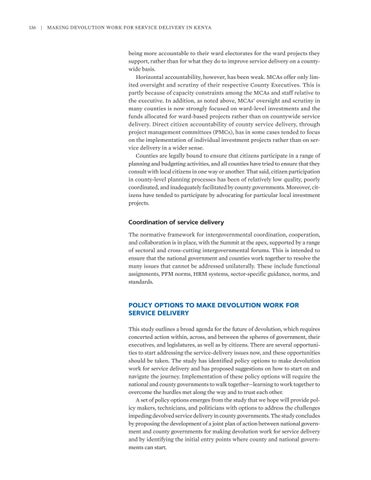136
|
Making Devolution Work for Service Delivery in Kenya
being more accountable to their ward electorates for the ward projects they support, rather than for what they do to improve service delivery on a countywide basis. Horizontal accountability, however, has been weak. MCAs offer only limited oversight and scrutiny of their respective County Executives. This is partly because of capacity constraints among the MCAs and staff relative to the executive. In addition, as noted above, MCAs’ oversight and scrutiny in many counties is now strongly focused on ward-level investments and the funds allocated for ward-based projects rather than on countywide service delivery. Direct citizen accountability of county service delivery, through project management committees (PMCs), has in some cases tended to focus on the implementation of individual investment projects rather than on service delivery in a wider sense. Counties are legally bound to ensure that citizens participate in a range of planning and budgeting activities, and all counties have tried to ensure that they consult with local citizens in one way or another. That said, citizen participation in county-level planning processes has been of relatively low quality, poorly coordinated, and inadequately facilitated by county governments. Moreover, citizens have tended to participate by advocating for particular local investment projects.
Coordination of service delivery The normative framework for intergovernmental coordination, cooperation, and collaboration is in place, with the Summit at the apex, supported by a range of sectoral and cross-cutting intergovernmental forums. This is intended to ensure that the national government and counties work together to resolve the many issues that cannot be addressed unilaterally. These include functional assignments, PFM norms, HRM systems, sector-specific guidance, norms, and standards.
POLICY OPTIONS TO MAKE DEVOLUTION WORK FOR SERVICE DELIVERY This study outlines a broad agenda for the future of devolution, which requires concerted action within, across, and between the spheres of government, their executives, and legislatures, as well as by citizens. There are several opportunities to start addressing the service-delivery issues now, and these opportunities should be taken. The study has identified policy options to make devolution work for service delivery and has proposed suggestions on how to start on and navigate the journey. Implementation of these policy options will require the national and county governments to walk together—learning to work together to overcome the hurdles met along the way and to trust each other. A set of policy options emerges from the study that we hope will provide policy makers, technicians, and politicians with options to address the challenges impeding devolved service delivery in county governments. The study concludes by proposing the development of a joint plan of action between national government and county governments for making devolution work for service delivery and by identifying the initial entry points where county and national governments can start.


